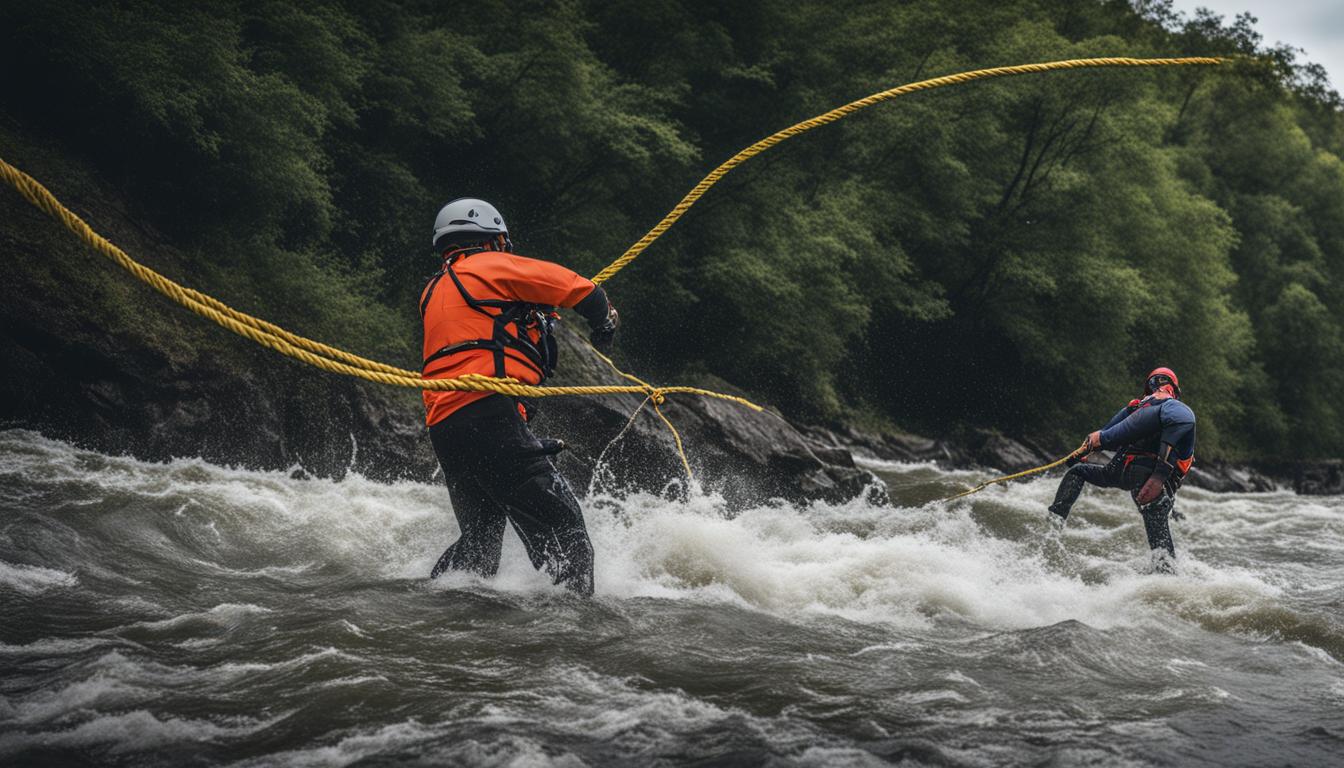Proper kayak storage is crucial to protect your investment and ensure its longevity. Many people make common mistakes when it comes to storing their kayaks, such as leaving them on the ground or exposing them to extreme weather conditions. By following expert advice and best practices, you can avoid these pitfalls and keep your kayak in top condition.
Key Takeaways:
- Avoid leaving your kayak on the ground.
- Protect your kayak from extreme weather conditions.
- Follow expert advice and best practices for proper storage.
- Consider short-term and long-term storage options.
- Clean your kayak before storing it to remove dirt and residue.
How to Store a Kayak: A Step-by-Step Guide
Proper kayak storage is essential to protect your investment and ensure its longevity. Whether you’re storing your kayak for short-term or long-term periods, following the correct techniques and guidelines is crucial. Here is a step-by-step guide to storing your kayak effectively:
Step 1: Clean your kayak
Before storing your kayak, it’s important to clean it properly to remove any dirt, debris, or residue. Use a mild soap or kayak cleaner and a soft sponge to gently clean the hull and cockpit. Rinse it thoroughly with fresh water and allow it to dry completely before moving on to the next step. Cleaning your kayak will help prevent any potential damage or deterioration while in storage.
Step 2: Choose a suitable storage location
For short-term storage, you can use a sturdy outdoor storage rack or a kayak storage rack indoors. Make sure the rack is stable and secure to prevent any accidents or damage. If you’re storing your kayak indoors for long-term periods, opt for a climate-controlled environment to protect it from extreme temperatures and humidity. Wooden planks, ceiling hooks, or wall racks can be great options for indoor storage.
Step 3: Position your kayak properly
When storing your kayak, it’s important to position it correctly to minimize any potential hull damage. Avoid storing it on a hard surface for an extended period, as this can cause deformation. Instead, use foam pads or pool noodles to support the kayak’s weight and distribute it evenly. Place the kayak on its side or upside down to prevent any warping or distortion.
Step 4: Cover and secure your kayak
To further protect your kayak, consider covering it with a UV-resistant kayak cover or a tarp. This will shield it from dust, dirt, and UV rays, especially during outdoor storage. If storing your kayak outdoors, ensure that it is securely tied down or locked to prevent theft or damage caused by strong winds or other external factors.
Follow these step-by-step guidelines to store your kayak properly and ensure its longevity. By investing time and effort into effective kayak storage methods, you can enjoy many adventures on the water with a well-maintained and protected kayak.

| Common Kayak Storage Mistakes | Proper Kayak Storage Techniques |
|---|---|
| Leaving the kayak on the ground | Use a sturdy storage rack |
| Exposing the kayak to extreme weather conditions | Store it in a climate-controlled environment |
| Storing the kayak on a hard surface | Use foam pads or pool noodles for support |
| Not cleaning the kayak before storage | Thoroughly clean the kayak to remove dirt and residue |
| Not covering the kayak | Use a UV-resistant cover or tarp for additional protection |
Kayak Storage: Indoors vs Outdoors
Deciding where to store your kayak is a crucial decision that can impact its condition and lifespan. There are pros and cons to both indoor and outdoor storage options, and understanding these factors will help you make an informed choice.
Indoor Kayak Storage
Storing your kayak indoors provides several advantages. Firstly, it offers better protection against the elements. Extreme weather conditions such as intense heat, cold temperatures, and prolonged exposure to sunlight can damage the kayak’s material and affect its structural integrity. By keeping it indoors, you can shield your kayak from these potential hazards.
Secondly, indoor storage helps prevent theft and vandalism. A securely locked garage, shed, or spare room offers a higher level of security compared to leaving your kayak outside. This is especially important if you live in an area with a higher risk of theft.
Outdoor Kayak Storage
While indoor storage is generally recommended, outdoor storage can be a viable option under certain circumstances. It is particularly suitable for short-term storage during the kayaking season when convenience and accessibility are key factors.
To protect your kayak during outdoor storage, it is crucial to take precautions. One option is to use a kayak cover to shield it from direct sunlight and rain. Alternatively, you can create a shelter using tarps and PVC pipes to provide additional protection from the elements.
The Decision
The decision of whether to store your kayak indoors or outdoors depends on various factors. Consider your available space, the climate in your area, and the level of security you require. While indoor storage offers superior protection and security, outdoor storage can be a practical option for shorter durations.
Ultimately, the goal is to keep your kayak in the best possible condition, so choose the storage method that suits your needs and ensures the longevity of your investment.

| Indoor Storage | Outdoor Storage | |
|---|---|---|
| Protection | Provides better protection against the elements | Requires additional measures to protect against weather conditions |
| Security | Offers higher security against theft and vandalism | May have a higher risk of theft or damage |
| Convenience | May require more effort to access the kayak | Offers easy access for short-term storage |
Conclusion
Proper kayak storage is essential to avoid common mistakes and ensure the longevity of your kayak. By following expert advice and best practices, such as storing the kayak indoors, using proper storage racks, and keeping it clean, you can protect your investment and keep it ready for adventure.
Avoiding mistakes in kayak storage is crucial to prevent damage, distortion, and theft. Make sure to choose a storage method that suits your space and climate. Consider both short-term and long-term storage options to keep your kayak in excellent condition every time you hit the water.
By being mindful of kayak storage pitfalls and implementing appropriate safety tips, you can enjoy your kayak for years to come. Remember to store your kayak indoors to protect it from the elements and potential theft. Keep it clean and use suitable storage racks to prevent hull damage. With these measures in place, your kayak will be ready for your next adventure whenever you are!
FAQ
What are some common mistakes people make when storing their kayaks?
Some common mistakes include leaving kayaks on the ground, exposing them to extreme weather conditions, and not properly cleaning them before storage.
What are the best options for short-term kayak storage?
For short-term storage, you can use sturdy outdoor storage racks or kayak storage racks indoors. Make sure to clean your kayak before storing it to remove dirt and residue.
What is the best way to store a kayak for long-term storage?
For long-term storage, it is best to store the kayak indoors in a climate-controlled environment. Options for indoor storage include using wooden planks, ceiling hooks, or wall racks. Avoid storing the kayak on a hard surface for an extended period of time to prevent hull damage.
Should I store my kayak indoors or outdoors?
Storing the kayak indoors provides better protection against the elements, theft, and damage. Indoor storage options include garages, sheds, or spare rooms. Outdoor storage can be suitable for short-term storage during the kayaking season, but precautions should be taken to protect the kayak from weather damage and theft.
How can I protect my kayak if I choose to store it outdoors?
If storing your kayak outdoors, you can use kayak covers or create a shelter using tarps and PVC pipes to protect it from the weather. However, indoor storage is generally recommended for better protection.
Why is proper kayak storage important?
Proper kayak storage is essential to avoid common mistakes and ensure the longevity of your kayak. By following expert advice and best practices, you can protect your investment, prevent damage, distortion, and theft, and keep your kayak in excellent condition for years to come.





